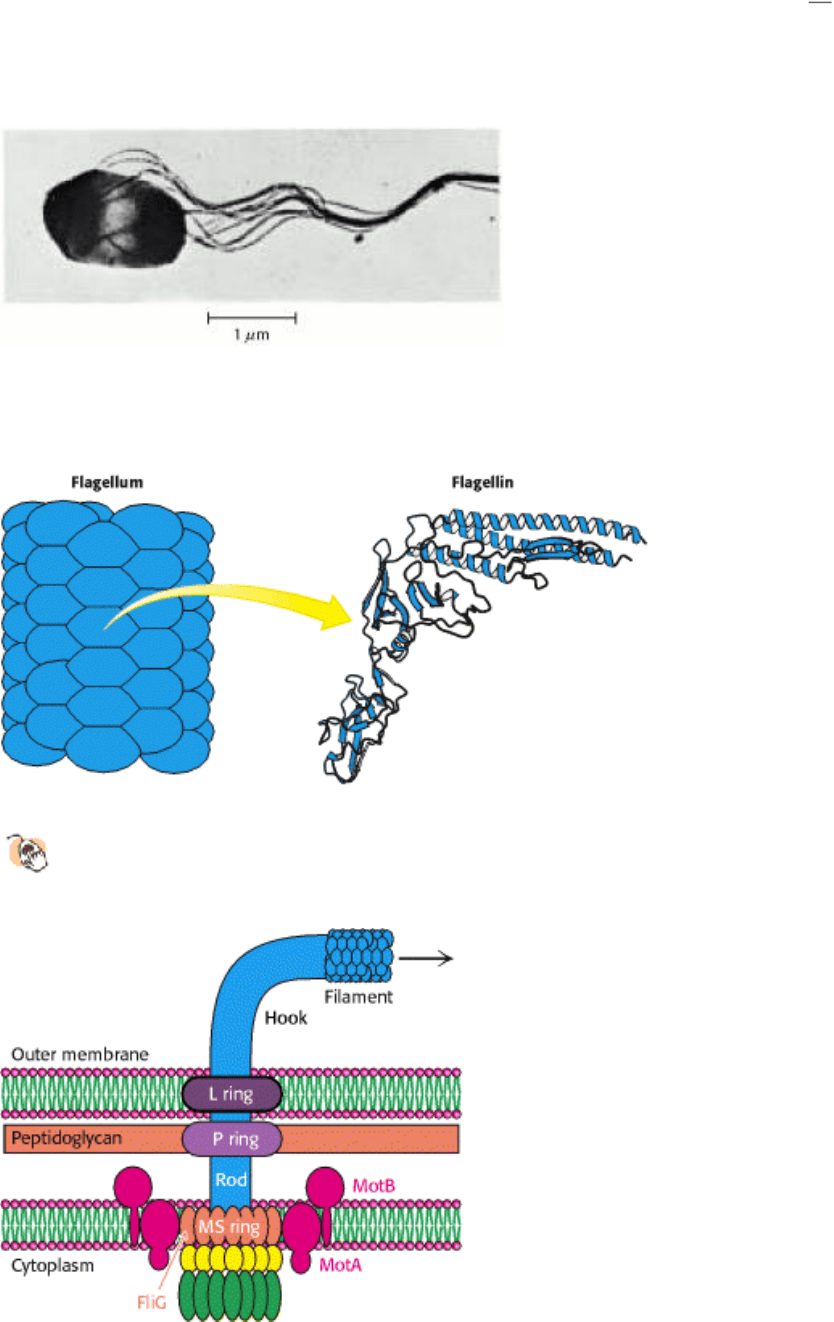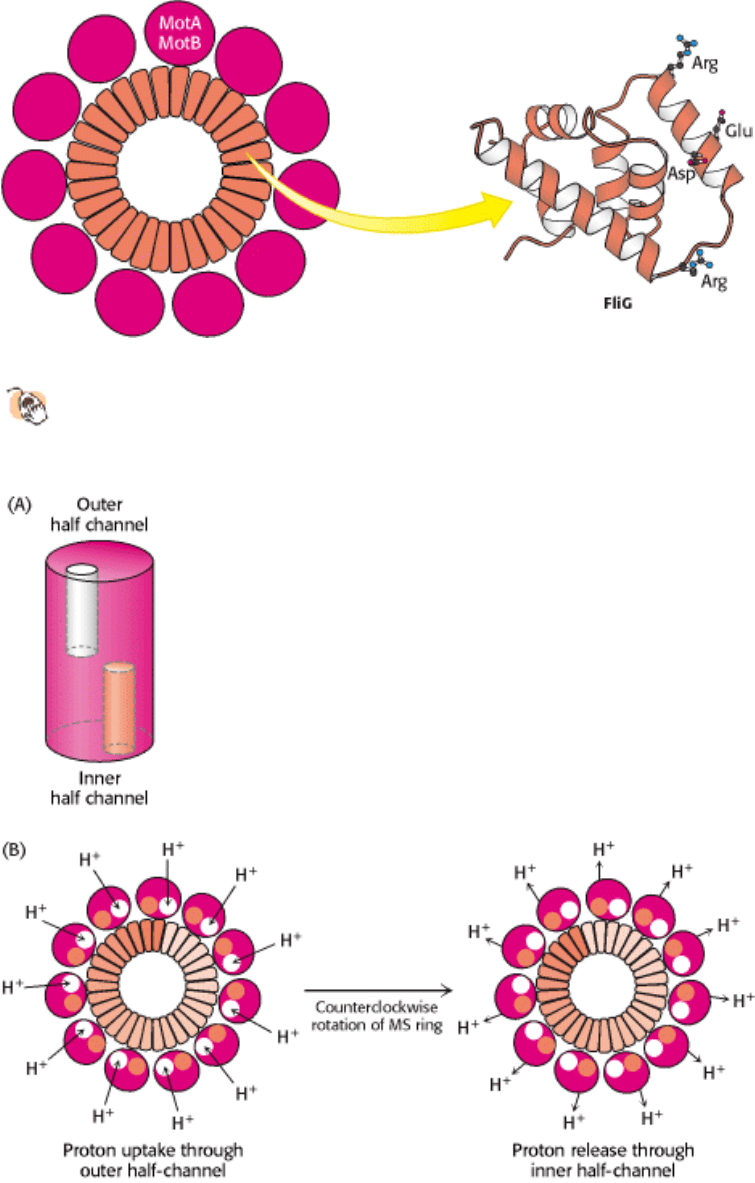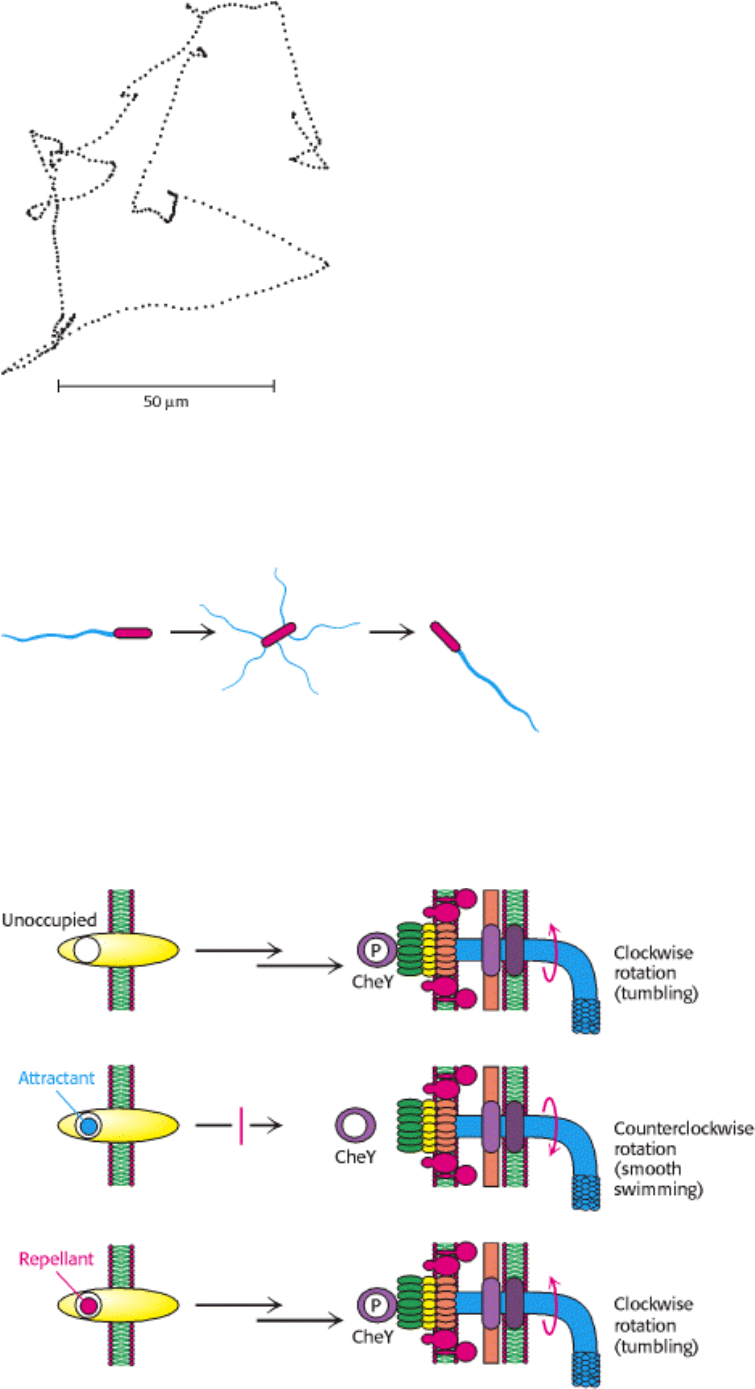Berg J.M., Tymoczko J.L., Stryer L. Biochemistry
Подождите немного. Документ загружается.


The MotA - MotB pair and FliG combine to create a proton channel that drives rotation of the flagellum. How can
proton flow across a membrane drive mechanical rotation? We have seen such a process earlier in regard to ATP
synthase (Section 18.4.4). Recall that the key to driving the rotation of the γ subunit of ATP synthase is the a subunit of
the F
0
fragment. This subunit appears to have two half-channels; protons can move across the membrane only by moving
into the half-channel from the side of the membrane with the higher local proton concentration, binding to a disc-like
structure formed by the c subunits, riding on this structure as it rotates to the opening of the other half-channel, and
exiting to the side with the lower local proton concentration. Could a similar mechanism apply to flagellar rotation?
Indeed, such a mechanism was first proposed by Howard Berg to explain flagellar rotation before the rotary mechanism
of ATP synthase was elucidated. Each MotA - MotB pair is conjectured to form a structure that has two half-channels;
FliG serves as the rotating proton carrier, perhaps with the participation of some of the charged resides identified in
crystallographic studies (Figure 34.32). In this scenario, a proton from the periplasmic space passes into the outer half-
channel and is transferred to an FliG subunit. The MS ring rotates, rotating the flagellum with it and allowing the proton
to pass into the inner half-channel and into the cell. Ongoing structural and mutagenesis studies are testing and refining
this hypothesis.
34.4.3. Bacterial Chemotaxis Depends on Reversal of the Direction of Flagellar
Rotation
Many species of bacteria respond to changes in their environments by adjusting their swimming behavior. Examination
of the paths taken is highly revealing (Figure 34.33). The bacteria swim in one direction for some length of time
(typically about a second), tumble briefly, and then set off in a new direction. The tumbling is caused by a brief reversal
in the direction of the flagellar motor. When the flagella rotate counterclockwise, the helical filaments form a coherent
bundle favored by the intrinsic shape of each filament, and the bacterium swims smoothly. When the rotation reverses,
the bundle flies apart because the screw sense of the helical flagella does not match the direction of rotation (Figure
34.34). Each flagellum then pulls in a different direction and the cell tumbles.
In the presence of a gradient of certain substances such as glucose, bacteria swim preferentially toward the direction of
the higher concentration of the substance. Such compounds are referred to as chemoattractants. Bacteria also swim
preferentially away from potentially harmful compounds such as phenol, a chemorepellant. The process of moving in
specific directions in response to environmental cues is called chemotaxis. In the presence of a gradient of a
chemoattractant, bacteria swim for longer periods of time without tumbling when moving toward higher concentrations
of chemoattractant. In contrast, they tumble more frequently when moving toward lower concentrations of
chemoattractant. This behavior is reversed for chemorepellants. The result of these actions is a biased random walk that
facilitates net motion toward conditions more favorable to the bacterium.
Chemotaxis depends on a signaling pathway that terminates at the flagellar motor. The signaling pathway begins with
the binding of molecules to receptors in the plasma membrane (Figure 34.35). In their unoccupied forms, these receptors
initiate a pathway leading eventually to the phosphorylation of a specific aspartate residue on a soluble protein called
CheY. In its phosphorylated form, CheY binds to the base on the flagellar motor. When bound to phosphorylated CheY,
the flagellar motor rotates in a clockwise rather than a counterclockwise direction, causing tumbling.
The binding of a chemoattractant to a surface receptor blocks the signaling pathway leading to CheY phosphorylation.
Phosphorylated CheY spontaneously hydrolyzes and releases its phosphate group in a process accelerated by another
protein, CheZ. The concentration of phosphorylated CheY drops, and the flagella are less likely to rotate in a clockwise
direction. Under these conditions, bacteria swim smoothly without tumbling. Thus, the reversible rotary flagellar motor
and a phosphorylation-based signaling pathway work together to generate an effective means for responding to
environmental conditions.
Bacteria sense spatial gradients of chemoattractants by measurements separated in time. A bacterium sets off in a
random direction and, if the concentration of the chemoattractant has increased after the bacterium has been swimming
for a period of time, the likelihood of tumbling decreases and the bacterium continues in roughly the same direction. If
the concentration has decreased, the tumbling frequency increases and the bacterium tests other random directions. The

success of this mechanism once again reveals the power of evolutionary problem solving many possible solutions are
tried at random, and those that are beneficial are selected and exploited.
IV. Responding to Environmental Changes 34. Molecular Motors 34.4. A Rotary Motor Drives Bacterial Motion
Figure 34.28. Bacterial Flagella. Electron micrograph of S. typhimurium shows flagella in a bundle. [Courtesy of Dr.
Daniel Koshland, Jr.]
IV. Responding to Environmental Changes 34. Molecular Motors 34.4. A Rotary Motor Drives Bacterial Motion
Figure 34.29. Structure of Flagellin.
A bacterial flagellum is a helical polymer of the protein flagellin.
IV. Responding to Environmental Changes 34. Molecular Motors 34.4. A Rotary Motor Drives Bacterial Motion
Figure 34.30. Flagellar Motor. A schematic view of the flagellar motor, a complex structure containing as many as 40
distinct types of protein. The approximate positions of the proteins MotA and MotB (red), FliG (orange), FliN (yellow),
and FliM (green) are shown.

IV. Responding to Environmental Changes 34. Molecular Motors 34.4. A Rotary Motor Drives Bacterial Motion
Figure 34.31. Flagellar Motor Components.
Approximately 30 subunits of FliG assemble to form part of the MS ring.
The ring is surrounded by approximately 11 structures consisting of MotA and MotB. The carboxyl-terminal
domain of FliG includes a ridge lined with charged residues that may participate in proton transport.
IV. Responding to Environmental Changes 34. Molecular Motors 34.4. A Rotary Motor Drives Bacterial Motion
Figure 34.32. Proton Transport-Coupled Rotation of the Flagellum. (A) MotA-MotB may form a structure having
two half-channels. (B) One model for the mechanism of coupling rotation to a proton gradient requires protons to be
taken up into the outer half-channel and transferred to the MS ring. The MS ring rotates in a counterclockwise direction,
and the protons are released into the inner half-channel. The flagellum is linked to the MS ring and so the flagellum
rotates as well.

IV. Responding to Environmental Changes 34. Molecular Motors 34.4. A Rotary Motor Drives Bacterial Motion
Figure 34.33. Charting a Course. This projection of the track of an E. coli bacterium was obtained with a microscope
that automatically follows bacterial motion in three dimensions. The points show the locations of the bacterium at 80-ms
intervals. [After H. C. Berg. Nature 254(1975):390.]
IV. Responding to Environmental Changes 34. Molecular Motors 34.4. A Rotary Motor Drives Bacterial Motion
Figure 34.34. Changing Direction. Tumbling is caused by an abrupt reversal of the flagellar motor, which disperses the
flagellar bundle. A second reversal of the motor restores smooth swimming, almost always in a different direction. [After
a drawing kindly provided by Dr. Daniel Koshland, Jr.]
IV. Responding to Environmental Changes 34. Molecular Motors 34.4. A Rotary Motor Drives Bacterial Motion
Figure 34.35. Chemotaxis Signaling Pathway. Receptors in the plasma membrane initiate a signaling pathway leading
to the phosphorylation of the CheY protein. Phosphorylated CheY binds to the flagellar motor and favors clockwise
rotation. When an attractant binds to the receptor, this pathway is blocked, and counterclockwise flagellar rotation and,
hence, smooth swimming results. When a repellant binds, the pathway is stimulated, leading to an increased
concentration of phosphoylated CheY and, hence, more frequent clockwise rotation and tumbling.
IV. Responding to Environmental Changes 34. Molecular Motors
Summary
Most Molecular-Motor Proteins Are Members of the P-Loop NTPase Superfamily
Eukaryotic cells contain three families of molecular-motor proteins: myosins, kinesins, and dyneins. These proteins
move along tracks defined by the actin and microtubule cytoskeletons of eukaryotic cells, contributing to cell and
organismal movement and to the intracellular transport of proteins, vesicles, and organelles. Despite considerable
differences in size and a lack of similarity detectable at the level of amino acid sequence, these proteins are homologous,
containing core structures of the P-loop NTPase family. The ability of these core structures to change conformations in
response to nucleoside triphosphate binding and hydrolysis is key to molecular-motor function. Motor proteins consist of
motor domains attached to extended structures that serve to amplify the conformational changes in the core domains and
to link the core domains to one another or to other structures.
Myosins Move Along Actin Filaments
The motile structure of muscle consists of a complex of myosin and actin, along with accessory proteins. Actin, a highly
abundant 42-kd protein, polymerizes to form long filaments. Each actin monomer can bind either ATP or ADP. Muscle
contraction entails the rapid sliding of thin filaments, based on actin, relative to thick filaments, composed of myosin. A
myosin motor domain moves along actin filaments in a cyclic manner: (1) myosin complexed to ADP and P
i
binds actin;
(2) P
i
is released; (3) a conformational change leads to a large motion of a lever arm that extends from the motor domain,
moving the actin relative to myosin; (4) ATP replaces ADP, resetting the position of the lever arm and releasing actin;
(5) the hydrolysis of ATP returns the motor domain to its initial state. The length of the lever arm determines the size of
the step taken along actin in each cycle. The ability to monitor single molecular-motor proteins has provided key tests for
hypotheses concerning motor function.
Kinesin and Dynein Move Along Microtubules
Kinesin and dynein move along microtubules rather than actin. Microtubules are polymeric structures composed of α-
and β-tubulin, two very similar guanine-nucleotide-binding proteins. Each microtubule comprises 13 protofilaments with
alternating α- and β-tubulin subunits. Kinesins move along microtubules by a mechanism quite similar to that used by
myosin to move along actin, but with several important differences. First, ATP binding to kinesin favors motor-domain
binding rather than dissociation. Second, the power stroke is triggered by the binding of ATP rather than the release of
P
i
. Finally, kinesin motion is processive. The two heads of a kinesin dimer work together, taking turns binding and
releasing the microtubule, and many steps are taken along a microtubule before both heads dissociate. Whereas most
kinesins move toward the plus end of a microtubule, some such as Drosophila ncd move in the opposite direction.
Movement in the direction of the minus end is accomplished through a mechanism very similar to that used for plus-end-
directed motion, but with critical structural differences accounting for the difference in direction.
A Rotary Motor Drives Bacterial Motion
Many motile bacteria use rotating flagella to propel themselves. When rotating counterclockwise, multiple flagella on the
surface of a bacterium come together to form a bundle that effectively propels the cell through solution. When rotating
clockwise, the flagella fly apart and the cell tumbles. In a homogeneous environment, bacteria swim smoothly for
approximately 1 second and then reorient themselves by tumbling. Bacteria swim preferentially toward chemoattractants
in a process called chemotaxis. When bacteria are swimming in the direction of an increasing concentration of a
chemoattractant, clockwise flagellar motion and tumbling is suppressed, leading to a biased random walk in the direction
of increasing chemoattractant concentration. A proton gradient across the plasma membrane, rather than ATP hydrolysis,
powers the flagellar motor. The mechanism for coupling transmembrane proton transport to macromolecular rotation
appears to be similar to that used by ATP synthase.
Key Terms
myosin
kinesin
dynein
S1 fragment
conventional kinesin
level arm
relay helix
neck linker
actin
myofibril
sarcomere
tropomyosin
troponin complex
G-actin
F-actin
critical concentration
optical trap
power stroke
microtubule
tubulin
dynamic instability
ncd (nonclaret disjunctional)

flagellin
MotA - MotB pair
FliG
chemoattractant
chemorepellant
chemotaxis
CheY
IV. Responding to Environmental Changes 34. Molecular Motors
Problems
1.
Diverse motors. Skeletal muscle, eukaryotic cilia, and bacterial flagella use different strategies for the conversion of
free energy into coherent motion. Compare and contrast these motility systems with respect to (a) the free-energy
source and (b) the number of essential components and their identity.
See answer
2.
You call that slow? At maximum speed, a kinesin molecule moves at a rate of 6400 Å per second. Given the
dimensions of the motor region of a kinesin dimer of approximately 80 Å, calculate its speed in "body lengths" per
second. What speed does this body-length speed correspond to for an automobile 10 feet long?
See answer
3.
Heavy lifting. A single myosin motor domain can generate a force of approximately 4 piconewtons (4 pN). How
many times its "bodyweight" can a myosin motor domain lift? Note that 1 newton = 0.22 pounds. Assume a
molecular mass of 100 kd for the motor domain.
See answer
4.
Rigor mortis. Why does the body stiffen after death?
See answer
5.
Now you see it, now you don't. Under certain stable concentration conditions, actin monomers in their ATP form will
polymerize to form filaments that disperse again into free actin monomers over time. Provide an explanation.
See answer
6.
Open and Schutt case? In our consideration of muscle contraction, we have assumed that actin filaments play an
entirely passive role, being pulled by myosin. What property of actin suggests that it might play a more active role?
See answer

7.
Designer kinesins. Hybrids of kinesin have been prepared that consist of either (a) the sequence of conventional
kinesin with the motor domain replaced by that of ncd or (b) the sequence of ncd with the motor domain replaced by
that of conventional kinesin. In which direction along microtubules would you predict these hybrid kinesins to move?
See answer
8.
Helicases as motors. Helicases such as PcrA (Section 27.2.5) can use single-stranded DNA as tracks. In each cycle,
the helicase moves one base in the 3
5 direction. Given that PcrA can hydrolyze ATP at a rate of 50 molecules
per second in the presence of a single-stranded DNA template, calculate the velocity of the helicase in micrometers
per second. How does this velocity compare with that of kinesin?
See answer
9.
New moves. When bacteria such as E. coli are starved to a sufficient extent, they become nonmotile. However, when
such bacteria are placed in an acidic solution, they resume swimming. Explain.
See answer
10.
Hauling a load. Consider the action of a single kinesin molecule in moving a vesicle along a microtubule track. The
force required to drag a spherical particle of radius a at a velocity v in a medium having a viscosity η is
Suppose that a 2-µm bead is carried at a velocity of 0.6 µm s
-1
in an aqueous medium (η = 0.01 poise = 0.01 g cm
-1
s
-1
).
(a) What is the magnitude of the force exerted by the kinesin molecule? Express the value in dynes (1 dyne = 1 g
cm s
-2
).
(b) How much work is performed in 1 second? Express the value in ergs (1 erg = 1 dyne cm).
(c) A kinesin motor hydrolyzes approximately 80 molecules of ATP per second. What is the energy associated with
the hydrolysis of this much ATP in ergs? Compare this value with the actual work performed.
See answer
11.
Unusual strides. A publication describes a kinesin molecule that is claimed to move along microtubules with a step
size of 6 nm. You are skeptical. Why?
See answer
12.
The sound of one hand clapping. KIF1A is a processive motor protein that moves toward the plus end of
microtubules as a monomer. KIF1A has only a single motor domain. What additional structural elements would
you expect to find in the KIF1A structure.
See answer
Mechanism Problem

13.
Backward rotation. On the basis of the proposed structure in Figure 34.32 for the bacterial flagellar motor, suggest
a pathway for transmembrane proton flow when the flagellar motor is rotating clockwise rather than
counterclockwise.
See answer
Chapter Integration Problem
14.
Smooth muscle. Smooth muscle, in contrast with skeletal muscle, is not regulated by a tropomyosin - troponin
mechanism. Instead, vertebrate smooth muscle contraction is controlled by the degree of phosphorylation of its
light chains. Phosphorylation induces contraction, and dephosphorylation leads to relaxation. Like that of skeletal
muscle, smooth muscle contraction is triggered by an increase in the cytoplasmic calcium ion level. Propose a
mechanism for this action of calcium ion on the basis of your knowledge of other signal-transduction processes.
See answer
Data Interpretation Problem
15.
Myosin V. An abundant myosin-family member, myosin V is isolated from brain tissue. This myosin has a number
of unusual properties. First, on the basis of its amino acid sequence, each heavy chain has six tandem binding sites
for calmodulin-like light chains. Second, it forms dimers but not higher-order oligomers. Finally, unlike almost all
other myosin-family members, myosin V is highly processive.
The rate of ATP hydrolysis by myosin has been examined as a function of ATP concentration, as shown in graph A.
(a) Estimate the values of k
cat
and K
M
for ATP.
With the use of optical-trap measurements, the motion of single myosin V dimers could be followed, as shown in
graph B.

(b) Estimate the step size for myosin V.
The rate of ADP release from myosin V is found to be approximately 13 molecules s
-1
.
(c) Combine the observations about the amino acid sequence of myosin, the observed step size, and the kinetics
results to propose a mechanism for the processive motion of myosin V.
[Based on M. Rief, R. S. Rock, A. D. Mehta, M. S. Mooseker, R. E. Cheney, and J. A. Spudich. Proc. Natl. Acad.
Sci. USA 97(2000):9482.]
See answer
IV. Responding to Environmental Changes 34. Molecular Motors
Selected Readings
Where to start
R.D. Vale and R.A. Milligan. 2000. The way things move: Looking under the hood of molecular motor proteins Science
288: 88-95. (PubMed)
R.D. Vale. 1996. Switches, latches, and amplifiers: Common themes of G proteins and molecular motors J. Cell Biol.
135: 291-302. (PubMed)
A.D. Mehta, M. Rief, J.A. Spudich, D.A. Smith, and R.M. Simmons. 1999. Single-molecule biomechanics with optical
methods Science 283: 1689-1695. (PubMed)
S.C. Schuster and S. Khan. 1994. The bacterial flagellar motor Annu. Rev. Biophys. Biomol. Struct. 23: 509-539.
(PubMed)
Books
Howard, J., 2001. Mechanics of Motor Proteins and the Cytosketon. Sinauer.
Squire, J. M., 1986. Muscle Design, Diversity, and Disease. Benjamin Cummings.
Pollack, G. H., and Sugi, H. (Eds.), 1984. Contractile Mechanisms in Muscle. Plenum.
Myosin and actin
K.C. Holmes. 1997. The swinging lever-arm hypothesis of muscle contraction Curr. Biol. 7: R112-R118. (PubMed)
